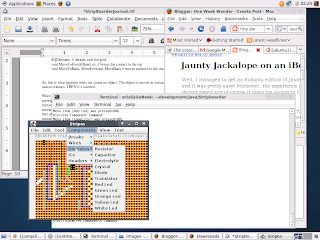Did anyone ever tell you what happened to the great ancient library of Alexandria? It was like a major wonder of the world and held so many classic texts that its destruction precipitated the half-millenium long Dark Ages. I've spent roughly 22 years under the unhappy impression a mob of brutal, ignorant Christians burnt it to the ground for the crime of being heretical. It turns out someone beat us to it.
By centuries.
You can read the entire story here. The point of this blog isn't really to shift the blame though, but my story of this story - how I kept coming across this myth and how different & more complex a more accurate history is.
This is how it goes. In my middle childhood to mid-teens I embraced Atheism, consciously understanding what it was about and genuinely valuing how science and reason had helped humanity progress beyond religion (as I understood it then). Part of this meant I was really into popular science literature and this is where I came across the story via the otherwise brilliant book Connections by James Burke.
At the time that made sense to me and I guess I internalised its point, but by the time I was doing my PGCE in 1990/1991 I'd become a Christian and forgotten it all; so I was quite shaken when a rather angry Atheist on my course launched into a tirade on the concrete walkways of UEA, using this an a prime example of why he really couldn't stand Christianity and Christians.
OK I thought, well Christians are perfectly capable of messing up badly. So the (indirect) shame stuck with me for about 10 years until I found myself on the Anvil Workshop course in 2001. Here I got a slightly different version of the story where the riot was caused because the female Librarian had moved the Library to a pagan temple (which the Christians wouldn't visit).
I should have started questioning the story a few years later when I found out that the Christianisation of Ireland beginning with St. Patrick (a real person, who never drank Guiness ;-) ) resulted in generations of Irish Christians who made the acquisition, preservation (and reading) of ancient literature a high priority. These amazing people were responsible for maintaining the majority of all such texts Europe had access to until the influx of books from the middle east after the Crusades.
I kinda just assumed they'd got them from elsewhere. It turns out that the history is both simpler and more subtly complex. To put it simply: Christians didn't burn the Library, it's a myth. More subtly, they couldn't have, because Alexandria had multiple libraries.
It's actually a conflation of stories. Alexandria had been burned down in ancient times, but not by Christians - Julius Caesar had accidentally done it in 48BC during an attack on the port. What the Christians did burn in AD391 were the Pagan temples by decree of Emperor Theodosius and although one of the temples had been used as part of a library there's no record of whether there were any books left in it by then.
So, our predecessors appear to be innocent on this particular count - jolly good :-) ! So what happened to all its books during the Dark Ages? Come to think of it, what happened to the Dark Ages? - I've heard contemporary historians figure that's a myth too ;-)








